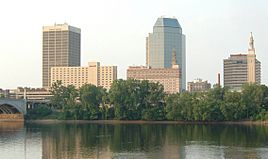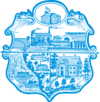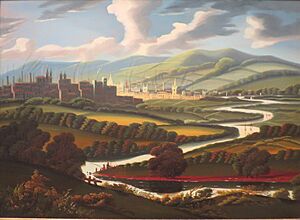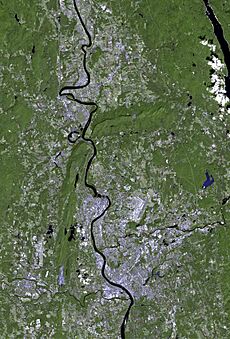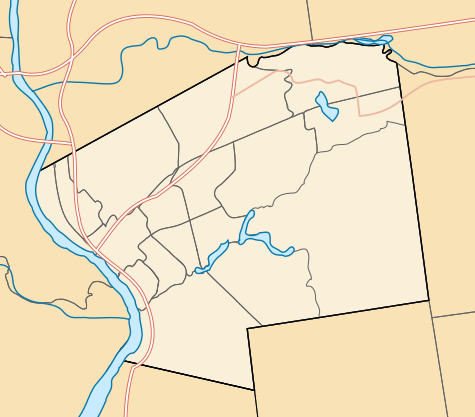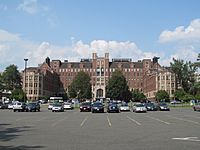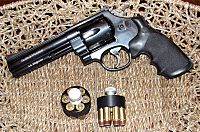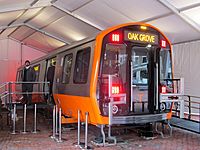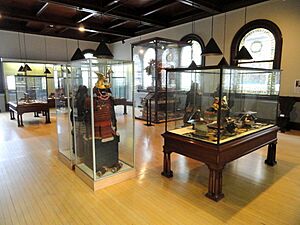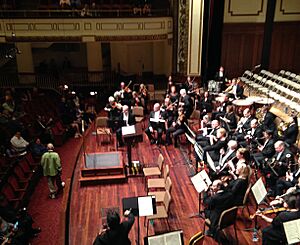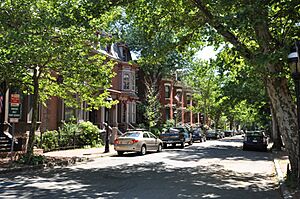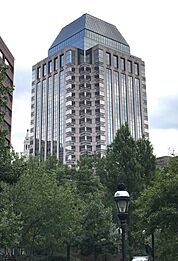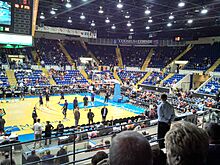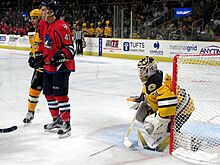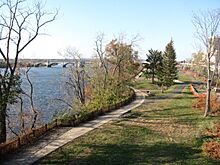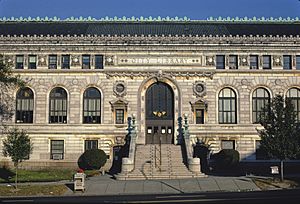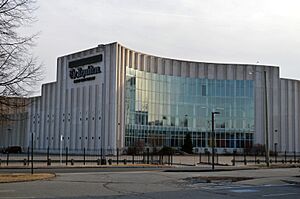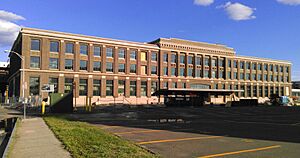Springfield, Massachusetts facts for kids
Quick facts for kids
Springfield, Massachusetts
|
|||||
|---|---|---|---|---|---|
|
City
|
|||||
|
Springfield skyline across the Connecticut River
The Puritan statue of pioneer Samuel Chapin
Hampden County Memorial Bridge overlooking the Connecticut River
|
|||||
|
|||||
| Nickname(s):
The City of Firsts; The City of Progress; The City of Homes; A City in the Forest; Hoop City;
The Western Gateway to New England |
|||||
| Country | United States | ||||
| State | Massachusetts | ||||
| County | Hampden | ||||
| Region | New England | ||||
| Historic countries | Kingdom of England Kingdom of Great Britain |
||||
| Historic colonies |
|
||||
| Settled (town) | May 14, 1636 | ||||
| Incorporated (city) | May 25, 1852 | ||||
| Founded by | William Pynchon | ||||
| Named for | Springfield, Essex | ||||
| Government | |||||
| • Type | Mayor-council city | ||||
| Area | |||||
| • City | 33.08 sq mi (85.68 km2) | ||||
| • Land | 31.87 sq mi (82.54 km2) | ||||
| • Water | 1.21 sq mi (3.14 km2) | ||||
| Elevation | 70 ft (21 m) | ||||
| Population
(2020)
|
|||||
| • City | 155,929 | ||||
| • Rank | 168th, U.S. as of 2020[update] incorporated places estimate | ||||
| • Density | 4,892.66/sq mi (1,889.08/km2) | ||||
| • Urban | 442,145 (US: 92nd) | ||||
| • Urban density | 2,191.4/sq mi (846.1/km2) | ||||
| • Metro | 699,162 (US: 87th) | ||||
| Demonym(s) | Springfieldian Springfielder |
||||
| Time zone | UTC−5 (Eastern) | ||||
| • Summer (DST) | UTC−4 (Eastern) | ||||
| ZIP Codes |
01101, 01103–01105, 01107–01109, 01118–01119, 01128–01129, 01151
|
||||
| Area code | 413 | ||||
| FIPS code | 25-67000 | ||||
| GNIS feature ID | 0609092 | ||||
| GDP | US$30 billion | ||||
Springfield is a major city in Massachusetts, United States. It is the biggest city in Hampden County. Springfield is located on the eastern side of the Connecticut River. It is close to where three other rivers meet: the Westfield River, the Chicopee River, and the Mill River.
In 2020, about 155,929 people lived in Springfield. This makes it the third largest city in Massachusetts. It is also the fourth largest city in New England, after Boston, Worcester, and Providence. The larger area around Springfield, called Metropolitan Springfield, had about 699,162 people in 2020.
Springfield was founded in 1636. It was the very first place named "Springfield" in the New World. During the American Revolution, George Washington chose Springfield for the Springfield Armory. This was because of its central location. The city also played a big part in the American Civil War. It was a stop on the Underground Railroad and home to John Brown. The Armory made many "Springfield rifles" used by Union soldiers. Today, the Springfield Armory is a national park site. It has the world's largest collection of old American firearms.
Today, Springfield is the largest city in western New England. It is a key city for business, economy, and media in the Pioneer Valley. Springfield has many nicknames. It's called "The City of Firsts" because many new things were invented there. These include the first American dictionary, the first American gas-powered car, and the first machine for making interchangeable parts. It's also known as "The City of Homes" because of its beautiful Victorian houses. And it's called "Hoop City" because basketball was invented here in 1891 by James Naismith.
Hartford, the capital of Connecticut, is about 24 miles (39 km) south of Springfield. The area around Hartford and Springfield is called the Knowledge Corridor. This is because it has over 160,000 university students. There are more than 32 universities and colleges here. This is the second-highest number of learning places in the United States. Springfield itself has Springfield College, Western New England University, American International College, and Springfield Technical Community College.
History of Springfield
Early Times and Native Americans
The land where Springfield is now was once home to Native American tribes. People lived here thousands of years ago. Archeologists have found old sites from different time periods.
When European settlers arrived, the Agawam tribe lived in the Springfield area. They sold land to the English settlers.
Colonial Beginnings and Challenges
Springfield was started in 1636 by William Pynchon. He was an English Puritan. He first called it "Agawam Plantation." In 1641, it was renamed "Springfield" after Pynchon's hometown in England. This happened after some disagreements and conflicts with Native American tribes. The settlement then joined the Massachusetts Bay Colony.
Springfield grew as a farming town and a trading post. But its success dropped a lot during King Philip's War in 1675. Native Americans attacked the town and burned most of it down. Many people survived by hiding in John Pynchon's brick house, called the "Old Fort." This was the first brick house in the Connecticut River Valley. Miles Morgan and his sons were seen as heroes for their actions during the attack.
The first settlement, which is now downtown Springfield, was built on high ground. It was where four rivers met. This spot was important for trade routes to cities like Boston, Albany, New York City, and Montreal. The soil around it was also very good for farming.
Growth and Innovations After the Revolution
In 1777, George Washington and Henry Knox chose Springfield for the Springfield Armory. This was because of its central location for transportation. The Armory made the first American musket in 1794. Later, it made the famous Springfield rifle. These rifles were used by soldiers in the American Civil War. The Armory attracted many skilled workers to Springfield. This made the city a center for making things with great precision.
The Armory was almost captured during Shays' Rebellion in 1787. This event helped lead to the creation of the U.S. Constitutional Convention. The Armory closed in 1969. Today, it is a National Historic Site. It has one of the world's largest collections of firearms.
During the 1800s and 1900s, many new things were invented in Springfield. These include:
- The first American-English dictionary (1805, Merriam-Webster).
- The first use of interchangeable parts in factories (1819, Thomas Blanchard).
- The first American gasoline-powered car (1893, Duryea Brothers).
- The first successful motorcycle company, "Indian" (1901).
- One of America's first commercial radio stations, WBZ (1921).
- Most famously, basketball (1891, Dr. James Naismith).
Companies like Smith & Wesson and Wason Manufacturing Company also grew here. Wason made train cars and was the largest railcar factory in New England. Springfield also made many other goods, like brass items, chemicals, and paper.
In the late 1900s, Springfield faced some challenges. The closing of the Armory and poor city planning caused some decline. But in the 2000s, the city began many projects to improve itself. These include new rail lines and a large casino. In 2022, Springfield was named an American World War II Heritage City. It was the first in Massachusetts.
Springfield's Geography
Springfield covers about 33.08 square miles (85.7 km2). About 1.21 square miles (3.1 km2) of this is water. The city was once called "The City in a Forest." It has over 4.0 square miles (10 km2) of parks. This is about 12% of its total land area.
Springfield is in the rich Connecticut River Valley. It is surrounded by mountains and hills. The city sits on the eastern bank of the Connecticut River. Two other important rivers, the Westfield River and the Chicopee River, flow into the Connecticut nearby. The border with Connecticut is only about 4 miles (6.4 km) south of Springfield.
The downtown area, called Metro Center, is mostly flat. It runs north to south along the Connecticut River. But as you go east, the city becomes more hilly.
A very important natural spot is Forest Park. It is 735 acres (2.97 km2) big. It is in the southwest part of the city. The park is surrounded by beautiful neighborhoods with many Victorian "Painted Lady" mansions. Springfield also shares borders with other towns like East Longmeadow, Wilbraham, and Chicopee.
Springfield's Climate
| Weather chart for Springfield, MA | |||||||||||||||||||||||||||||||||||||||||||||||
|---|---|---|---|---|---|---|---|---|---|---|---|---|---|---|---|---|---|---|---|---|---|---|---|---|---|---|---|---|---|---|---|---|---|---|---|---|---|---|---|---|---|---|---|---|---|---|---|
| J | F | M | A | M | J | J | A | S | O | N | D | ||||||||||||||||||||||||||||||||||||
|
3.2
35
18
|
2.9
39
21
|
3.6
48
28
|
3.7
61
38
|
4.4
71
48
|
4.4
80
57
|
4.2
85
63
|
3.9
83
61
|
3.9
75
53
|
4.4
63
41
|
3.9
52
33
|
3.4
40
23
|
||||||||||||||||||||||||||||||||||||
| temperatures in °F precipitation totals in inches |
|||||||||||||||||||||||||||||||||||||||||||||||
|
Metric conversion
|
|||||||||||||||||||||||||||||||||||||||||||||||
Springfield has four clear seasons. Winters are cold, with an average temperature around 26°F (-3°C) in January. Snowstorms can bring a lot of snow. Summers are very warm and sometimes humid. The average temperature in July is around 74°F (23°C). Some days in summer can get hotter than 90°F (32°C). Spring and fall are usually pleasant.
The city gets about 45.85 inches (116.5 cm) of rain each year. It gets about 40.5 inches (103 cm) of snow. Big weather events like hurricanes and tornadoes are not common. But on June 1, 2011, a large tornado hit Springfield. It caused a lot of damage to the city.
| Climate data for Bradley International Airport, Connecticut (1981–2010 normals, extremes 1905–present) | |||||||||||||
|---|---|---|---|---|---|---|---|---|---|---|---|---|---|
| Month | Jan | Feb | Mar | Apr | May | Jun | Jul | Aug | Sep | Oct | Nov | Dec | Year |
| Record high °F (°C) | 72 (22) |
73 (23) |
89 (32) |
96 (36) |
99 (37) |
100 (38) |
103 (39) |
102 (39) |
101 (38) |
91 (33) |
83 (28) |
76 (24) |
103 (39) |
| Mean maximum °F (°C) | 55.6 (13.1) |
57.4 (14.1) |
70.1 (21.2) |
82.9 (28.3) |
89.0 (31.7) |
92.8 (33.8) |
95.1 (35.1) |
94.1 (34.5) |
88.7 (31.5) |
79.4 (26.3) |
70.8 (21.6) |
59.0 (15.0) |
97.2 (36.2) |
| Mean daily maximum °F (°C) | 34.5 (1.4) |
38.5 (3.6) |
47.7 (8.7) |
60.5 (15.8) |
71.2 (21.8) |
79.6 (26.4) |
84.5 (29.2) |
82.7 (28.2) |
74.9 (23.8) |
63.1 (17.3) |
51.6 (10.9) |
39.7 (4.3) |
60.7 (15.9) |
| Mean daily minimum °F (°C) | 17.7 (−7.9) |
20.9 (−6.2) |
27.9 (−2.3) |
38.4 (3.6) |
47.7 (8.7) |
57.3 (14.1) |
62.7 (17.1) |
61.1 (16.2) |
52.7 (11.5) |
41.1 (5.1) |
33.2 (0.7) |
23.4 (−4.8) |
40.3 (4.6) |
| Mean minimum °F (°C) | −2 (−19) |
1.9 (−16.7) |
10.7 (−11.8) |
26.2 (−3.2) |
33.5 (0.8) |
44.2 (6.8) |
51.5 (10.8) |
48.4 (9.1) |
37.8 (3.2) |
26.9 (−2.8) |
17.5 (−8.1) |
6.0 (−14.4) |
−4.5 (−20.3) |
| Record low °F (°C) | −26 (−32) |
−24 (−31) |
−6 (−21) |
9 (−13) |
28 (−2) |
37 (3) |
44 (7) |
36 (2) |
30 (−1) |
17 (−8) |
1 (−17) |
−18 (−28) |
−26 (−32) |
| Average precipitation inches (mm) | 3.23 (82) |
2.89 (73) |
3.62 (92) |
3.72 (94) |
4.35 (110) |
4.35 (110) |
4.18 (106) |
3.93 (100) |
3.88 (99) |
4.37 (111) |
3.89 (99) |
3.44 (87) |
45.85 (1,165) |
| Average snowfall inches (cm) | 12.3 (31) |
11.0 (28) |
6.4 (16) |
1.4 (3.6) |
0 (0) |
0 (0) |
0 (0) |
0 (0) |
0 (0) |
0 (0) |
2.0 (5.1) |
7.4 (19) |
40.5 (103) |
| Average precipitation days (≥ 0.01 inch) | 10.8 | 9.7 | 11.5 | 11.2 | 12.8 | 12.2 | 10.4 | 10.0 | 9.8 | 10.2 | 10.7 | 10.7 | 130.0 |
| Average snowy days (≥ 0.1 inch) | 5.8 | 4.7 | 3.5 | 0.5 | 0 | 0 | 0 | 0 | 0 | 0 | 0.9 | 4.7 | 20.1 |
| Average relative humidity (%) | 63.9 | 63.0 | 60.4 | 58.0 | 63.0 | 67.3 | 68.0 | 70.6 | 72.9 | 69.2 | 68.3 | 68.0 | 66.0 |
| Mean monthly sunshine hours | 169.8 | 176.1 | 213.9 | 228.2 | 258.6 | 273.4 | 293.1 | 269.6 | 223.6 | 199.4 | 139.4 | 139.5 | 2,584.6 |
| Percent possible sunshine | 58 | 59 | 58 | 57 | 57 | 60 | 64 | 63 | 60 | 58 | 47 | 49 | 58 |
| Source: NOAA (relative humidity and sun 1961–1990) | |||||||||||||
Springfield's Neighborhoods
Springfield has 17 different neighborhoods. Each one has its own unique feel. Here are a few examples:
- Forest Park: This area has the large Forest Park. It also has many beautiful Victorian homes.
- Indian Orchard: This used to be a separate town. It has old mill buildings that artists now use.
- The McKnight Historic District: This was America's first planned neighborhood. It has over 900 Victorian "Painted Lady" houses.
- Metro Center: This is the downtown area. It has many cultural places, shops, and restaurants.
- South End: This neighborhood is known for its Italian-American restaurants and festivals. It is also home to the Naismith Memorial Basketball Hall of Fame.
People of Springfield
| Historical racial composition | 2020 | 2010 | 1990 | 1970 | 1940 |
|---|---|---|---|---|---|
| White | 63.3% | 51.8% | 68.5% | 87% | 97.9% |
| —Non-Hispanic | 31.2% | 36.7% | 63.6% | 84.1% | − |
| Black or African American | 20.9% | 22.3% | 19.2% | 3.3% | 2.1% |
| Hispanic or Latino (of any race) | 45% | 38.8% | 16.9% | 3.3% | − |
| Asian | 2.7% | 2.4% | 1% | 0.1% | − |
Population Details
| Race / Ethnicity (NH = Non-Hispanic) | Pop 2000 | Pop 2010 | Pop 2020 | % 2000 | % 2010 | % 2020 |
|---|---|---|---|---|---|---|
| White alone (NH) | 74,291 | 56,248 | 44,046 | 48.85% | 36.75% | 28.25% |
| Black or African American alone (NH) | 29,831 | 29,934 | 28,548 | 19.62% | 19.56% | 18.31% |
| Native American or Alaska Native alone (NH) | 336 | 329 | 259 | 0.22% | 0.21% | 0.17% |
| Asian alone (NH) | 2,857 | 3,615 | 4,426 | 1.88% | 2.36% | 2.84% |
| Pacific Islander alone (NH) | 42 | 47 | 75 | 0.03% | 0.03% | 0.05% |
| Some Other Race alone (NH) | 236 | 248 | 863 | 0.16% | 0.16% | 0.55% |
| Mixed Race or Multi-Racial (NH) | 3,146 | 3,188 | 4,838 | 2.07% | 2.08% | 3.10% |
| Hispanic or Latino (any race) | 41,343 | 59,451 | 72,874 | 27.18% | 38.84% | 46.74% |
| Total | 152,082 | 153,060 | 155,929 | 100.00% | 100.00% |
Springfield has a diverse population. In 2010, about 51.8% of people were White, and 22.3% were Black or African American. About 38.8% of the population was Hispanic or Latino. Many people in Springfield are of Puerto Rican background.
Springfield's Economy
Distribution of Greater Springfield NECTA Labor Force (2016) Nat'l resources & mining (1%) Construction (5%) Manufacturing (10%) Trade, transportation & utilities (18%) Information (2%) Finance & real estate (6%) Professional & business services (8%) Educational & health services (33%) Leisure & hospitality (9%) Other services (4%) Government (4%)
| Top Springfield companies for 2018 (ranked by revenues) with City and U.S. ranks Source: Fortune 500 |
|||||||
| Spfld. | Corporation | US | Revenue (in millions) |
||||
| 1 | MassMutual | 93 | $33,495.4 | ||||
| 2 | Eversource Energy | 364 | $7,752 | ||||
| Top City Employers Source: MA Executive Office of Labor and Workforce Development |
|||||||
| Rank | Company/Organization | ||||||
| 1 | Baystate Medical Center | ||||||
| 2 | Smith & Wesson | ||||||
| 3 | General Dynamics | ||||||
| 4 | MassMutual | ||||||
| 5 | Mercy Medical Center | ||||||
| 6 | U.S. Postal Service | ||||||
| 7 | Big Y Foods | ||||||
| 8 | Massachusetts Trial Court | ||||||
| 9 | Springfield Republican | ||||||
| 10 | Springfield College | ||||||
Springfield's location is great for moving goods. It is close to Boston, New York City, and Montreal. In the early 1900s, it was a big producer of cakes and bread.
Today, Springfield's main industries are:
- Education and Health Services
- Trade and Transportation
- Manufacturing
- Tourism and Hospitality
- Professional & Business Services
Springfield is known for its "mature economy." This helps protect the city during tough economic times. It also has a growing market with many different cultures.
The Hartford–Springfield area is called the Knowledge Corridor. This is because it has 32 universities and colleges. There are over 160,000 students in this area. These schools help create a skilled workforce. This leads to a strong economy. Springfield is also a center for high-tech jobs.
Major Businesses in Springfield
Springfield is the economic heart of Western Massachusetts. It has many retail stores, factories, and medical groups.
- MassMutual Financial Group: This is the largest Fortune 100 company in Massachusetts.
- Smith & Wesson: This company makes handguns. It was founded in 1852.
- Merriam-Webster: This company publishes the first American-English dictionary. It started in 1806.
- Baystate Health: This is the third largest employer in Massachusetts. It has over 10,000 employees. Baystate is also a teaching campus for Tufts University School of Medicine.
- American Hockey League: The main league for developing NHL players is based here.
- Big Y: A regional supermarket chain.
- Peter Pan Bus Lines: A bus company with its headquarters in Springfield.
Past Companies of Note
Springfield has been home to many famous companies over the years:
- Forbes & Wallace: A regional department store.
- Friendly Ice Cream Corporation: Started in Springfield.
- Indian Motocycle Manufacturing Company: America's first motorcycle brand.
- Milton Bradley Company: A famous game company.
- Rolls-Royce: The only place outside Britain where Rolls-Royce luxury cars were built.
- Sheraton Hotels and Resorts: This hotel chain was founded in Springfield.
- Springfield Armory: A key military firearms producer for the U.S.
- Wason Manufacturing Company: A large railway car maker.
Arts and Culture in Springfield
Food Scene
Springfield's many different cultures have shaped its food. There are old restaurants and new ones.
- Smith's Billiards: Opened in 1902.
- The Student Prince Cafe: A German restaurant open since 1935.
- Italian restaurants: Frigo's (1950), The Red Rose (1963), and Leone's (1988).
- Other cuisines: You can find Cajun, Lebanese, Puerto Rican, Greek, Jamaican, Mexican, and Vietnamese food.
Festivals and Events
Springfield hosts many fun festivals throughout the year:
- Armory Big Band Concerts: 1940s music at the Springfield Armory in summer.
- Basketball Hall of Fame Enshrinement Weekend: A week of events for new members.
- Bright Nights: Over 600,000 lights in Forest Park from Thanksgiving to New Year's Day.
- Caribbean Festival: Held in late August with a parade and music.
- Glendi: A three-day Greek festival in September with food and music.
- Hoop City Jazz Festival: An annual jazz music event.
- Mattoon Street Arts Festival: An art festival.
- Our Lady of Mount Carmel Society Festival: A mid-July Italian celebration with food and a parade.
- Parade of Big Balloons: A Thanksgiving parade with huge balloons.
- Star Spangled Springfield: An Independence Day celebration with fireworks.
- World's Largest Pancake Breakfast: An attempt to break a Guinness record for pancakes.
Museums to Explore
Springfield has five unique museums at the Quadrangle. It also has the beautiful Springfield City Library.
- Museum of Fine Arts: Features a large collection of Impressionist art.
- George Walter Vincent Smith Art Museum: Has a big collection of Chinese cloisonne.
- Springfield Science Museum: Features a life-size Tyrannosaurus Rex and the first American-made planetarium.
- Amazing World of Dr. Seuss Museum: Dedicated to Theodor Geisel, who was born in Springfield.
- Lyman and Merrie Wood Museum of Springfield History: Tells the story of the city's many innovations.
The Titanic Museum in the Indian Orchard neighborhood displays rare items from the famous ship.
Music Scene
Springfield has a lively music scene.
- Springfield Symphony Orchestra: Performs at Springfield Symphony Hall.
- Rock Music: Bands like Staind, All That Remains, and Shadows Fall started here.
- Jazz and Blues: These music styles are also very popular. The Hoops City Jazz & Art Festival brings many people to hear jazz music.
Fun Places to Visit
- Basketball Hall of Fame: A special place dedicated to basketball. It is located where basketball was invented.
- Bright Nights: A beautiful lighting display in Forest Park during the holidays.
- City Stage: Offers plays, comedians, and shows for children.
- Club Quarter: An area with many clubs, restaurants, and bars.
- Connecticut River Walk Park: A park along the Connecticut River with great views.
- Court Square: A historic park in downtown Springfield. It is surrounded by amazing buildings.
- Dr. Seuss National Memorial Sculpture Garden: Features large bronze statues of characters from Dr. Seuss's books.
- First Game of Basketball Sculpture: An illuminated sculpture marking where the first basketball game was played.
- Forest Park: One of the largest urban parks in the U.S. It has a zoo, a lake, playgrounds, and many other features.
- King Philip's Stockade: A historic park where a major attack happened during King Philip's War.
- MassMutual Center: An arena and convention center that hosts hockey games and concerts.
- Mulberry Street: The street that inspired Dr. Seuss's first children's book.
- The Puritan: A famous statue that has become a symbol of Springfield.
- The Quadrangle: A campus of five museums.
- St. John's Congregational Church: A historic church important in the abolitionist movement. John Brown attended services here.
- Stacy Building: The place where the first American gasoline-powered car was built.
- Six Flags New England: A large amusement park just outside Springfield.
- The Springfield Armory National Historic Site: A historic site with a museum of firearms.
- Symphony Hall: A beautiful hall known for its "perfect acoustics." It hosts the Springfield Symphony Orchestra.
Springfield's Architecture
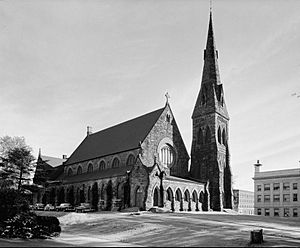
Springfield is known as "The City of Homes" because of its attractive buildings. Many houses are Victorian "Painted Ladies," similar to those in San Francisco. You can also find older mansions and modern buildings.
In downtown Springfield, there are two tall skyscrapers: Tower Square and Monarch Place. Monarch Place is the tallest building in Massachusetts outside of Boston. Many old buildings, like former hotels and factories, have been turned into apartments and condos.
Neighborhoods like Forest Park and McKnight National Historic District have many beautiful Victorian homes. McKnight was America's first planned neighborhood.
Springfield has worked to improve its downtown area. New projects include renovations to Union Station and new buildings like the Federal Building.
Public Library System
Springfield has a public library system. The main branch is the Springfield City Library. The city spends money each year to support its libraries. Springfield has the second-largest library circulation in Massachusetts, after Boston.
Sports in Springfield
Springfield has a rich sports history.
- Basketball: The sport was invented here.
- Volleyball: The first exhibition match was held at Springfield College.
- Ice Hockey: Springfield is home to the headquarters of the American Hockey League. The Springfield Thunderbirds play their home games at the MassMutual Center.
- Baseball: Springfield has had professional baseball teams in the past, like the Springfield Giants.
Parks and Outdoor Fun
Springfield is known as a "Greenest City" in the U.S. It has over 2,400 acres (9.7 km2) of parkland. These are spread across 35 urban parks.
- Forest Park: This is a very large and important urban park. It has the Zoo at Forest Park, a lake, playgrounds, and many trails. It also hosts the Bright Nights lighting display.
- Apremont Triangle Park: A small park in downtown Springfield.
- Armoury Commons: A park near the Springfield Armory with sculptures.
- Connecticut River Walk Park: A long park along the Connecticut River with trails and views.
- Court Square: A historic park in downtown Springfield with monuments and beautiful buildings.
- Five Mile Pond: A natural park with a pond popular for boating.
- King Philip's Stockade: A historic park with picnic areas and views of the Connecticut River Valley.
- Leonardo da Vinci Park: A small park in the Italian South End.
- Pynchon Park: A unique park that connects downtown with the museums.
- Stearns Square: A park in the Club Quarter with artistic details.
- Van Horn Park: A large park with two ponds.
Biking in Springfield
The Connecticut River Walk Park offers a great bike route. The city is also adding e-bike share stations for easy cycling.
Education in Springfield
Schools for Kids (K–12)
Springfield has the second-largest school district in Massachusetts. It runs many elementary schools, middle schools, and high schools. Some main high schools are High School of Commerce, Springfield Central High School, and Springfield High School of Science and Technology. There are also charter schools like SABIS International.
The Roman Catholic Diocese of Springfield operates Pope Francis Preparatory School, a large Catholic high school. Other private schools include Pioneer Valley Christian Academy.
Colleges and Universities
The Knowledge Corridor area around Springfield has many colleges. It has the second-highest number of higher learning places in the U.S.
- Western New England University
- Springfield College: Famous as the place where basketball was invented.
- American International College: Known for starting the Model Congress program.
- Springfield Technical Community College: Built on the old Springfield Armory site. It focuses on technical innovation.
Many other well-known colleges are close by, such as Amherst College, Smith College, Mount Holyoke College, and the University of Massachusetts Amherst.
Media in Springfield
Newspapers
Springfield's main local newspaper is The Republican. Other smaller papers also serve the area. There are also newspapers for specific communities, like El Pueblo Latino for the Hispanic community and Unity First for the African-American community.
Television Channels
Springfield has a long history of TV broadcasting.
| Channel (digital/virtual) | Call sign | Network | Owner |
|---|---|---|---|
| 11/22 | WWLP | NBC/CW (through The CW Plus) (DT2) Ion Television (DT3) |
Nexstar Media Group |
| 21/3.5 | WSHM-LD | CBS | Gray Television |
| 13/57 | WGBY | PBS | WGBH Educational Foundation Operated by New England Public Media |
| 21/22 | WFXQ-CD | NBC++ | Nexstar Media Group |
| 34 | WTXX-LD | Independent | Tyche Broadcasting |
| 40 | WGGB | ABC, FOX/MyNetworkTV (DT2) | Gray Television |
| 43 | WHTX-LP | Univision | Entravision Communications |
++WFXQ-CD rebroadcasts WWLP.
- WWLP-TV (Channel 22): This is the NBC station for the area.
- WGGB (Channel 40): This is the ABC and Fox station.
- WSHM-LD (Channel 3): This is Springfield's CBS station.
- WGBY (Channel 57): This is the PBS station for the area.
Radio Stations
Springfield was home to the first commercial radio station in the U.S., WBZ. It started broadcasting from the Hotel Kimball before moving to Boston.
| Callsign | Frequency | City/town | Network affiliation / owner | Format |
|---|---|---|---|---|
| WFCR | 88.5 FM | Springfield | University of Massachusetts Amherst | Public Radio |
| WSKB | 89.5 FM | Westfield | Westfield State University | College Radio |
| WSCB | 89.9 FM | Springfield | Springfield College | College Radio |
| WTCC | 90.7 FM | Springfield | Springfield Technical Community College | Public Radio |
| WAIC | 91.9 FM | Springfield | American International College | College Radio |
| WHYN-FM | 93.1 FM | Springfield | iHeartMedia | Hot Adult Contemporary (Top 40 on HD2) |
| WMAS-FM | 94.7 FM | Enfield, Connecticut | Entercom | Adult contemporary (Country on HD2) |
| WLZX-FM | 99.3 FM | Northampton | Saga Communications of New England | "Everything That Rocks" |
| WLCQ-LP | 99.7 FM | Feeding Hills | Lighthouse Christian Center | Christian Rock/Pop Music, "The Q" |
| WRNX | 100.9 FM | Amherst | iHeartMedia | Country |
| WAQY | 102.1 FM | Springfield | Saga Communications of New England | Classic rock |
| WCCH | 103.5 FM | Holyoke | Holyoke Community College | College Radio |
| WNEK-FM | 105.1 FM | Springfield | Western New England University | College Radio |
| WWEI | 105.5 FM | Easthampton/Springfield | Entercom | Sports Talk (simulcast of WEEI-FM in Boston) |
| WEIB | 106.3 FM | Northampton/Springfield | Cutting Edge Broadcasting | Smooth Jazz |
| WHYN | 560 AM | Springfield | iHeartMedia | News/Talk |
| WNNZ | 640 AM | Westfield | University of Massachusetts Amherst | Public Radio (programmed by WFCR) |
| WACE | 730 AM | Chicopee | Carter Broadcasting Corporation | Religious |
| WARE | 1250 AM | Ware | Success Signal Broadcasting | Oldies |
| WACM | 1270 AM | Springfield | Davidson Media Group | Spanish |
| WHLL | 1450 AM | Springfield | Entercom | Sports Radio (CBS Sports Radio affiliate) |
| WSPR | 1490 AM | Springfield | Davidson Media Group | Spanish |
Springfield's Infrastructure
Getting Around Springfield: Transportation
Springfield is called the "Crossroads of New England." This is because it's a major hub for shipping goods. It's located where many routes from New York City, Boston, and Montreal meet. The city has many advantages for trade. It's on the Connecticut River and has good soil. It also has many train lines and highways. These include I-90 (the Mass Pike) and I-91.
Train Travel
Springfield Union Station is a major train station. It was reopened in 2017 after renovations. Five Amtrak train routes serve the station. These include the Vermonter and the Lake Shore Limited. The Amtrak Hartford Line and CT Rail's Hartford Line also connect Springfield to New Haven, Connecticut. These lines offer commuter rail service for the region.
Bus Services
The Pioneer Valley Transit Authority (PVTA) is based in Springfield. It uses Union Station as its main hub. The PVTA runs 19 bus routes from Union Station. These routes serve Springfield and nearby towns. Long-distance bus services like Peter Pan Bus Lines and Greyhound Lines also operate from Union Station.
Airports Near Springfield
Springfield is mainly served by Bradley International Airport. This airport is in Windsor Locks, Connecticut, about 12 miles (19 km) south of downtown. It has over 100 flights daily to many destinations. Other local airports include Westfield-Barnes Regional Airport and Westover Metropolitan Airport. Logan International Airport in Boston is about 80 miles (129 km) away.
Biking Paths
The city's Connecticut River Walk Park has a great bike route. It runs from the north to the south end of the city. There are also e-bike share stations in Springfield and West Springfield.
Water and Sewer System
The Springfield Water and Sewer Commission manages the city's water system. It owns reservoirs and aqueducts. The city gets its drinking water from places like Borden Brook Reservoir and Cobble Mountain Reservoir. The Ludlow Reservoir is kept as an emergency water supply.
Emergency Services
The Springfield Fire Department provides fire protection and emergency medical services. It is one of the oldest fire departments in the United States.
Famous People from Springfield
- Creighton Abrams, U.S. Army general
- Johnny Appleseed, American folk hero
- Thomas Blanchard, inventor of the lathe and early car
- Milton Bradley, inventor of parlor games
- John Brown, abolitionist
- Ruth E. Carter, Oscar-winning costume designer
- John Cena, WWE wrestler
- Shamus Culhane, lead animator at Walt Disney Studios
- Theodor Seuss Geisel (a.k.a. Dr. Seuss), famous children's author
- Charles Goodyear, inventor of vulcanized rubber
- Richard F. Heck, Nobel Prize winner in Chemistry
- Alan Kay, computer scientist
- Edward Tsang Lu, astronaut
- William Manchester, historian and author
- Rabbit Maranville, professional baseball player
- Miles Morgan, hero from King Philip's War
- James Naismith, inventor of basketball
- Larry O'Brien, former NBA Commissioner
- Robert B. Parker, author
- William Pynchon, founder of Springfield
- Kurt Russell, actor
- Augustus Saint-Gaudens, sculptor
- Mike Scully, writer and producer for The Simpsons
- Chloë Sevigny, actress
- Daniel Shays, leader of Shays' Rebellion
- Eddie Shore, professional hockey player
- Staind, alternative rock band
- Taj Mahal, blues musician
- Paul Weston, composer
- James McNeill Whistler, painter
See also
 In Spanish: Springfield (Massachusetts) para niños
In Spanish: Springfield (Massachusetts) para niños


